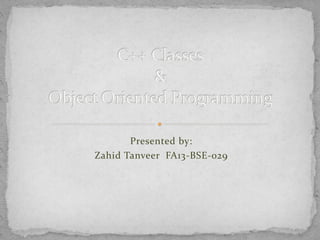
C++ classes
- 1. Presented by: Zahid Tanveer FA13-BSE-029
- 2. Programmer thinks about and defines the attributes and behavior of objects. Often the objects are modeled after real-world entities. Very different approach than function-based programming (like C).
- 3. Object-oriented programming (OOP) Encapsulates data (attributes) and functions (behavior) into packages called classes. So, Classes are user-defined (programmer-defined) types. Data (data members) Functions (member functions or methods) In other words, they are structures + functions
- 4. A class definition begins with the keyword class. The body of the class is contained within a set of braces, { } ; (notice the semi-colon). class class_name { …. …. …. }; Class body (data member + methods) Any valid identifier
- 5. Within the body, the keywords private: and public: specify the access level of the members of the class. the default is private. Usually, the data members of a class are declared in the private: section of the class and the member functions are in public: section.
- 6. class class_name { private: … … … public: … … … }; Public members or methods private members or methods
- 7. Member access specifiers public: can be accessed outside the class directly. The public stuff is the interface. private: Accessible only to member functions of class Private members and methods are for internal use only.
- 8. This class example shows how we can encapsulate (gather) a circle information into one package (unit or class) class Circle { private: double radius; public: void setRadius(double r); double getDiameter(); double getArea(); double getCircumference(); }; No need for others classes to access and retrieve its value directly. The class methods are responsible for that only. They are accessible from outside the class, and they can access the member (radius)
- 9. Declaring a variable of a class type creates an object. You can have many variables of the same type (class). Instantiation Once an object of a certain class is instantiated, a new memory location is created for it to store its data members and code You can instantiate many objects from a class type. Ex) Circle c;
- 10. Constructor: Public function member called when a new object is created (instantiated). Initialize data members. Same name as class No return type Several constructors Function overloading
- 11. class Circle { private: double radius; public: Circle(); Circle(int r); void setRadius(double r); double getDiameter(); double getArea(); double getCircumference(); }; Constructor with no argument Constructor with one argument
- 12. Class implementation: writing the code of class methods. There are two ways: 1. Member functions defined outside class Using Binary scope resolution operator (::) “Ties” member name to class name Uniquely identify functions of particular class Different classes can have member functions with same name Format for defining member functions ReturnType ClassName::MemberFunctionName( ){ … }
- 13. 2. Member functions defined inside class Do not need scope resolution operator, class name; class Circle { private: double radius; public: Circle() { radius = 0.0;} Circle(int r); void setRadius(double r){radius = r;} double getDiameter(){ return radius *2;} double getArea(); double getCircumference(); }; Defined inside class
- 14. class Circle { private: double radius; public: Circle() { radius = 0.0;} Circle(int r); void setRadius(double r){radius = r;} double getDiameter(){ return radius *2;} double getArea(); double getCircumference(); }; Circle::Circle(int r) { radius = r; } double Circle::getArea() { return radius * radius * (22.0/7); } double Circle:: getCircumference() { return 2 * radius * (22.0/7); } Defined outside class
- 15. Operators to access class members Identical to those for structs Dot member selection operator (.) Object Reference to object
- 16. class Circle { private: double radius; public: Circle() { radius = 0.0;} Circle(int r); void setRadius(double r){radius = r;} double getDiameter(){ return radius *2;} double getArea(); double getCircumference(); }; Circle::Circle(int r) { radius = r; } double Circle::getArea() { return radius * radius * (22.0/7); } double Circle:: getCircumference() { return 2 * radius * (22.0/7); } void main() { Circle c1,c2(7); cout<<“The area of c1:” <<c1.getArea()<<“n”; //c1.raduis = 5;//syntax error c1.setRadius(5); cout<<“The circumference of c1:” << c1.getCircumference()<<“n”; cout<<“The Diameter of c2:” <<c2.getDiameter()<<“n”; } The first constructor is called The second constructor is called Since radius is a private class data member
- 17. Destructors Special member function Same name as class Preceded with tilde (~) No arguments No return value Cannot be overloaded Before system reclaims object’s memory Reuse memory for new objects Mainly used to de-allocate dynamic memory locations
- 18. This class shows #include<iostream> Using namespace std; class Test { private: int n; public: Test() { cout<<“Object is Created………”<<endl; } ~Test() { cout<<“object is destroyed”<<endl; } }; Void main() { Test a,b; getchar(); Getchar(); } Destructor
